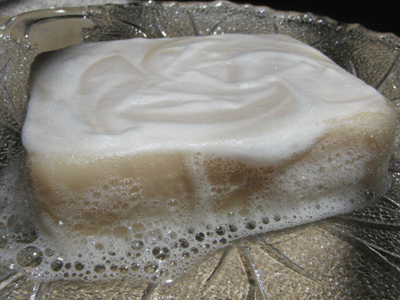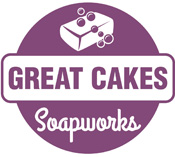Fabulous Shampoo Bar Recipe
If you are a soapmaker looking for a fabulous shampoo bar recipe with lots of lather that will make your hair softer than it’s ever been before, then this recipe is for you! It comes from Lisa G. of Opus Soaps in Petersburg, Texas.
When I first set out to make a great shampoo bar, I did a bit of research on the best ingredients to use and took a shot at it. It worked fine for my first try, and my hair did a slow transition away from the commercial shampoo I’ve been using all my life. It had decent lather, and made my hair feel softer and cleaner than it ever had before. In fact, here’s a photo of it:

Then Lisa sent me her recipe, and I whipped up a quick hot-processed batch. Oh my. My first soap never saw this much lather! And my hair! After the first time using it, my hair was noticeably softer and easier to comb through!

Oh, but then Lisa sent me an actual bar that she had made using the cold process method, and it was EVEN BETTER. When I first picked it up, I noticed how silky smooth the surface of the soap felt. Then with a bit of water added, the lather began to grow into an lots of large frothy bubbles. After rubbing it around my hair, I noticed that the lather got super dense and creamy. Heavenly! See for yourself:

Are you ready to make your own batch now? Here is what you’ll need:
Opus Shampoo Bar – 3 lb. batch, superfatted at 5%
Water – 517 g (Lisa uses half beer, half aloe juice)
Lye – 192 g
Coconut Oil – 382 g
Olive Oil Pomace – 408 g
Castor Oil – 63 g
Lard – 340 g
Shea Butter – 42 g
Cocoa Butter – 25 g
Rice Bran Oil – 123 g
I’ve been using this recipe on my hair for several days and it’s amazing! I’m still using a bit of conditioner on the ends followed by a vinegar rinse (about 1 part apple cider vinegar, 3 parts water) on my scalp, which works down through the hair and makes it easier to de-tangle. After getting my hair shampooed at the salon yesterday, I did have to shampoo my hair twice with the bar soap to get the same lather, and my hair isn’t feeling quite as soft today. I suppose it will have to re-adjust again.
Anyway, give it a shot and let me know how it works for you! And huge thanks to Lisa for sharing her recipe!!
If you haven’t made soap with beer before, you might want to consult this post.
Page with Comments
Comments are closed.

Do you make aloe juice from the plant or do you buy it already made?
@Carly – I buy it by the gallon online. You can get it at Walmart though.
Hi Amy, can I substitute mango butter for lard? Thanks a lot!
@Barbir – You can. It won’t have the same properties as lard – lard has more palmitic fatty acids, and mango butter has more stearic. But try it!
I want to try this recipe I have everything but shea butter. Is there a substitute or should I just wait and get some. I can’t wait to make this
@Tiffany – Mango butter would be a suitable substitute for shea butter.
Can I use a substitute for rice bran oil. I need suggestions….
@Gretchen – Olive oil is considered a good sub for rice bran oil.
Is this recipe for hot processed or cold?
@Gretchen – It’s for cold process, but you can make it with hot process too!
Thank you so much for this receipe. I made it last week using hot process. Couldn’t wait for 6 weeks. I used it for the first time today and I’m in love. It’s wonderful. Will be making more of this.
@Tiffany – That’s wonderful! Thanks for letting me know!!
Can you use regular olive oil?
@Dawn – Of course!
Thank you so much for this recipe!! I’d like to make a vegan version of this. What do you recommend substituting the lard for?
@Dana – Palm oil is the closest to lard.
Hi Amy, I’m new to soap making and interested in making nourishing shampoo bars. I stumbled across your site and would love to try your recipe. Could you assist with the following?
I’m not familiar with Olive Oil Pomace.. I don’t think its available in South Africa. Can I use regular olive oil in the recipe and increase the amount if using as a substitute for Rice Bran Oil which is also not freely available here? Could I use fresh aloe vera leaves liquidized and strained instead of aloe juice and use palm oil as a substitute for the lard? How would all these changes affect the recipe? Would i need to adjust the lye?
Many thanks for your assistance.
Faith
@Faith – You can do all of these substitutions without causing too much difference in the final soap, but you will definitely need to recalculate the lye amount.
can all cold process recipes be hot processed? is there any changes that need made to the ingredients?
@suzie – Technically, yes! Just make sure you are using the full recommended water amount for your lye solution.
Im new making shampoo, can i replace lye with surfactant SCI?
@Alex – Surfactant based recipes are entirely different. You cannot just replace the lye with a surfactant, no.
Genial formula!!! Gracias por compartirla!! Como no conseguí aceite de arroz, lo sustitui por aceite de aguacate e hice infusión de hierbas con la cerveza… el resultado…Fabuloso!!!!!
I have limp fine hair, the recipe I made in the past made it to greasy and heavy, making it flat. I wonder if this recipe would work for fine limp hair?
@Sherry – I would think that the lower superfat would definitely help with that. My hair is very fine also, but I have a fair amount of it. It worked well for me! It’s also important to work through the transition phase (up to 2 weeks) of switching to a shampoo bar. Your hair will go through “greasy, heavy” phase before getting to the super amazing lightweight feel. Also – if you have hard water, it is very difficult to get good results with a shampoo bar. Just some other things to consider!
I have another question. I have new to soap making and have made only a few batches, I found a recipe that looked good, but instead of putting ounces or grams, they have 10 % of this oil and 5% of this oil. How do I know how much to try in the recipe? Am I missing something?
@Sherry – This is quite common as it allows you to scale the recipe to the size batch you need. Use a soap calculator like http://soapcalc.net/calc/SoapCalcWP.asp to figure out how much you will need of each oil and the lye and water amount.
Can this be used on the body as well as hair?
@Denise – I believe it could.
I am allergic to coconut. What substitution can I make?
@Mary – Babassu oil is an excellent replacement for coconut!
I’m curious, do you know what the PH level of this shampoo is? I have not made any soaps yet, looking forward to trying it out. This looks like a good one to try.
@Marietta – I haven’t tested it, actually, but my guess is that it would be similar to other handmade cold process soaps which are generally around a 9 on the pH scale.
Too many people have no knowledge of the fact that scalp therapy shampoos for fast hair growth (of course with no sulfates, no parabens, no DEA) are a thing. We are now able to have longer hair and have more options. For sure worth researching.
When you’re thinking about alopecia, damaged hair, avoiding scalp disorders, hair growth, hair and scalp health at large, the same rules become relevant.
In most cases, you should try to avoid hair products and treatments that contain chemicals such as parabens, DEA and sulfates.
What’s good for your hair is healthy for your skin also.
For obvious reasons your content here hits the nail in the head for many reasons. It stays away from the accustomed pitfalls and mistakes most fall into: utilizing bad alternatives. Greatly appreciated!